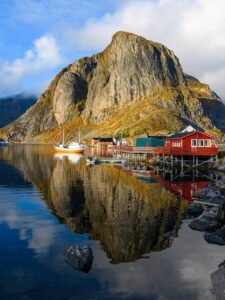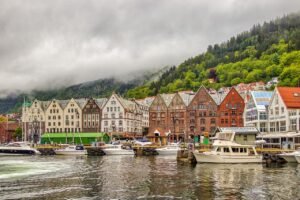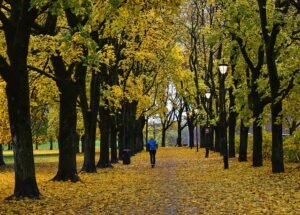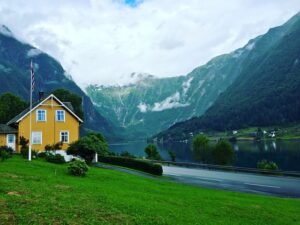

Animal Talk: Learning Norwegian Vocabulary for Animal Lovers
For animal lovers, being able to communicate about animals is an essential part of their passion. Whether you are visiting Norway or living there, learning Norwegian vocabulary related to animals can greatly enhance your experience. Not only will it allow you to better understand and appreciate the local wildlife, but it will also enable you to have meaningful conversations with locals about animals.
One of the main benefits of learning Norwegian animal vocabulary is the ability to communicate with locals about animals. Norway is known for its diverse wildlife, from domesticated animals to wild creatures that roam its forests and fjords. By learning the Norwegian words for different animals, you can engage in conversations with locals about their pets, local wildlife, and conservation efforts. This not only allows you to connect with the people around you but also deepens your understanding and appreciation of the country’s natural beauty.
Table of Contents
ToggleBasic Norwegian Vocabulary for Domesticated Animals
Norway, like any other country, has its fair share of domesticated animals. From cats and dogs to horses and rabbits, these animals play an important role in the lives of many Norwegians. To effectively communicate about these animals, it is essential to learn some basic Norwegian vocabulary.
When it comes to cats, the Norwegian word for cat is “katt.” If you want to specify the gender of the cat, you can use “hankatt” for a male cat and “hunkatt” for a female cat. Similarly, the word for dog in Norwegian is “hund.” To differentiate between male and female dogs, you can use “hanhund” for a male dog and “tispe” for a female dog.
Horses are also popular in Norway, especially in rural areas where they are used for various purposes such as farming and recreational activities. The Norwegian word for horse is “hest.” To describe a male horse, you can use “hingst,” and for a female horse, you can use “hoppe.”
Understanding Norwegian Terminology for Wild Animals
Norway is home to a wide variety of wild animals, ranging from majestic reindeer to elusive lynx. To fully appreciate and understand the wildlife in Norway, it is important to familiarize yourself with the Norwegian terminology for identifying and describing these animals.
One of the most iconic animals in Norway is the reindeer, known as “rein” in Norwegian. These beautiful creatures are often associated with the Sami people, who have a deep cultural connection with them. Another notable wild animal in Norway is the lynx, which is called “gaupe” in Norwegian. The lynx is known for its elusive nature and stunning appearance.
Other wild animals you may encounter in Norway include the moose (“elg”), the Arctic fox (“fjellrev”), and the brown bear (“brunbjørn”). By learning the Norwegian words for these animals, you can better appreciate their presence in the country and engage in conversations about them with locals.
Learning Norwegian Words for Birds and Their Behaviors
Norway is a haven for birdwatchers, with its diverse range of bird species that inhabit its forests, mountains, and coastal areas. To fully enjoy birdwatching in Norway and understand the behaviors and characteristics of different bird species, it is important to learn the Norwegian vocabulary related to birds.
Some common birds you may encounter in Norway include the seagull (“måke”), the blackbird (“svarttrost”), and the great tit (“kjøttmeis”). Each of these birds has unique behaviors and characteristics that can be described using specific Norwegian words.
For example, if you want to describe a bird’s song or call, you can use the word “sang” or “kall.” If you want to talk about a bird’s flight, you can use the word “flyging.” By learning these words and others related to bird behaviors, you can enhance your birdwatching experience in Norway and have more meaningful conversations with fellow bird enthusiasts.
Identifying Norwegian Vocabulary for Fish and Aquatic Creatures
Norway is famous for its stunning fjords and abundant marine life. From salmon and cod to whales and seals, the country’s waters are teeming with a diverse range of fish and aquatic creatures. To fully appreciate and understand the marine life in Norway, it is important to learn the Norwegian vocabulary related to fish and aquatic creatures.
Some common fish you may encounter in Norway include the Atlantic salmon (“laks”), the cod (“torsk”), and the herring (“sild”). Each of these fish has unique characteristics that can be described using specific Norwegian words.
In addition to fish, Norway is also home to various aquatic creatures such as whales, seals, and dolphins. The Norwegian word for whale is “hval,” while the word for seal is “sel.” By learning these words and others related to fish and aquatic creatures, you can better appreciate the marine life in Norway and engage in conversations about them with locals.
Norwegian Vocabulary for Insects and Arachnids

Insects and arachnids may not be everyone’s cup of tea, but they play an important role in ecosystems around the world, including Norway. To better understand and appreciate these small creatures, it is important to learn the Norwegian vocabulary related to insects and arachnids.
Some common insects you may encounter in Norway include the butterfly (“sommerfugl”), the bee (“bie”), and the ladybug (“mariehøne”). Each of these insects has unique characteristics that can be described using specific Norwegian words.
Arachnids, such as spiders, are also present in Norway. The Norwegian word for spider is “edderkopp.” By learning these words and others related to insects and arachnids, you can better appreciate the role they play in the ecosystem and engage in conversations about them with locals.
Recognizing Norwegian Words for Reptiles and Amphibians
Norway may not be known for its reptiles and amphibians, but they do exist in the country’s diverse habitats. To better understand and appreciate these creatures, it is important to learn the Norwegian vocabulary related to reptiles and amphibians.
Some common reptiles you may encounter in Norway include the common lizard (“firfisle”) and the slowworm (“hugorm”). Each of these reptiles has unique characteristics that can be described using specific Norwegian words.
Amphibians, such as frogs and toads, are also present in Norway. The Norwegian word for frog is “frosk,” while the word for toad is “padde.” By learning these words and others related to reptiles and amphibians, you can better appreciate their presence in Norway and engage in conversations about them with locals.
Expanding Your Norwegian Animal Vocabulary for Exotic Species
While Norway may not be known for its exotic animals, there are still some unique species that can be found in the country. To fully appreciate and understand these exotic animals, it is important to expand your Norwegian animal vocabulary.
Some exotic animals you may encounter in Norway include the Arctic fox (“fjellrev”), the muskox (“moskus”), and the Eurasian lynx (“gaupe”). Each of these animals has unique characteristics that can be described using specific Norwegian words.
By learning the Norwegian vocabulary for exotic animals, you can better appreciate their presence in Norway and engage in conversations about them with locals. This not only allows you to connect with the people around you but also deepens your understanding of the country’s diverse wildlife.
Using Norwegian Animal Vocabulary to Communicate with Locals
Being able to communicate about animals with locals is not only a fun way to connect with people but also a valuable skill when visiting or living in Norway. Whether you are discussing your love for pets, asking for recommendations on wildlife spotting, or engaging in conversations about conservation efforts, having a good understanding of Norwegian animal vocabulary can greatly enhance your interactions.
For example, if you are visiting a local farm and want to ask about the different animals they have, being able to use the correct Norwegian words for cows, pigs, and chickens will make your conversation more meaningful. Similarly, if you are interested in wildlife photography and want to ask locals about the best spots for birdwatching or where to find reindeer, having the right vocabulary will help you communicate your interests effectively.
Furthermore, being able to discuss conservation efforts and environmental issues related to animals in Norway can help you connect with locals who share your passion for wildlife. By using the correct Norwegian terminology, you can engage in meaningful conversations about topics such as habitat preservation, endangered species, and sustainable practices.
Practicing Norwegian Animal Vocabulary through Immersion and Activities
Learning Norwegian animal vocabulary doesn’t have to be a daunting task. There are many ways to practice and reinforce your knowledge in a fun and engaging way.
One of the best ways to practice animal vocabulary is through immersion. If you are visiting or living in Norway, try to immerse yourself in the local culture by attending events or activities related to animals. This could include visiting farms, nature reserves, or wildlife rehabilitation centers where you can interact with animals and engage in conversations with locals.
Another way to practice animal vocabulary is through activities such as birdwatching or hiking. As you observe different animals in their natural habitats, try to identify them using their Norwegian names. You can also keep a journal where you write down the names of animals you encounter and their characteristics in Norwegian. This will not only help you remember the vocabulary but also deepen your understanding of the animals and their behaviors.
Conclusion
Learning Norwegian animal vocabulary is an important skill for animal lovers visiting or living in Norway. It allows you to connect with locals, appreciate the country’s diverse wildlife, and engage in meaningful conversations about animals. By familiarizing yourself with basic Norwegian vocabulary for domesticated animals, wild animals, birds, fish, insects, reptiles, amphibians, and exotic species, you can enhance your experience and deepen your understanding of Norway’s natural beauty. So, whether you are planning a trip to Norway or have already made it your home, take the time to learn and practice Norwegian animal vocabulary – it will open up a whole new world of animal talk for you.
If you’re an animal lover learning Norwegian, you’ll definitely want to check out this related article on how to handle your dog like a pro. From basic commands to advanced training techniques, this article covers it all. Whether you’re a beginner or an experienced dog owner, you’ll find valuable tips and tricks to improve your communication with your furry friend. So why wait? Start mastering Norwegian dog commands today! Learn more here.
If you want to learn Norwegian, you can register for classes here. We look forward to hearing from you and helping you become fluent in Norwegian.





